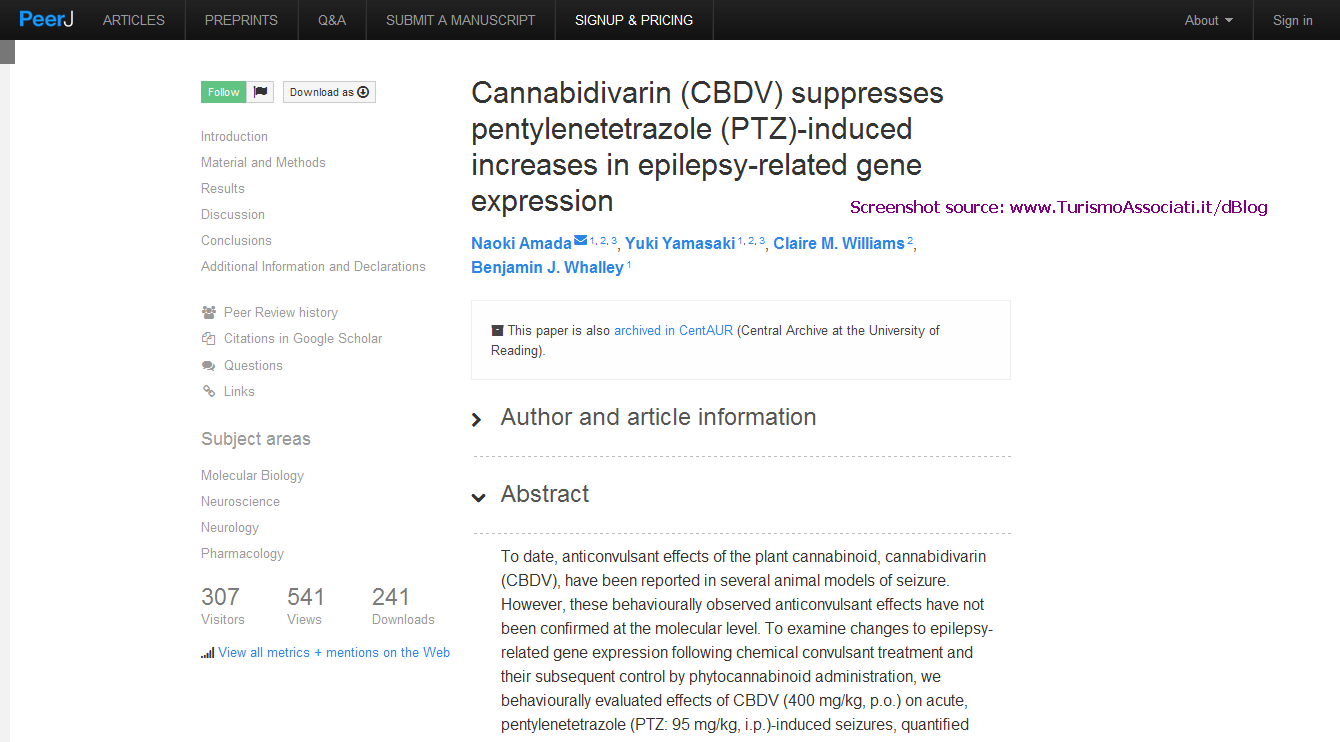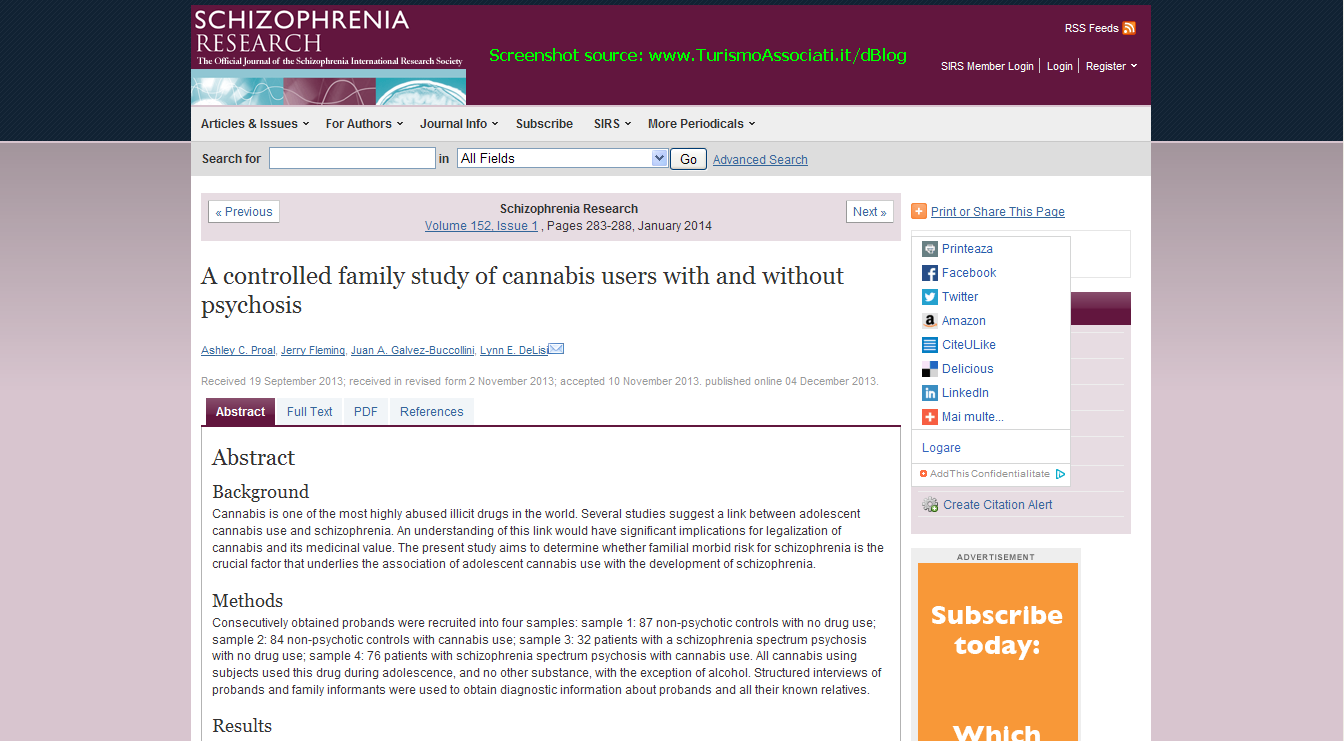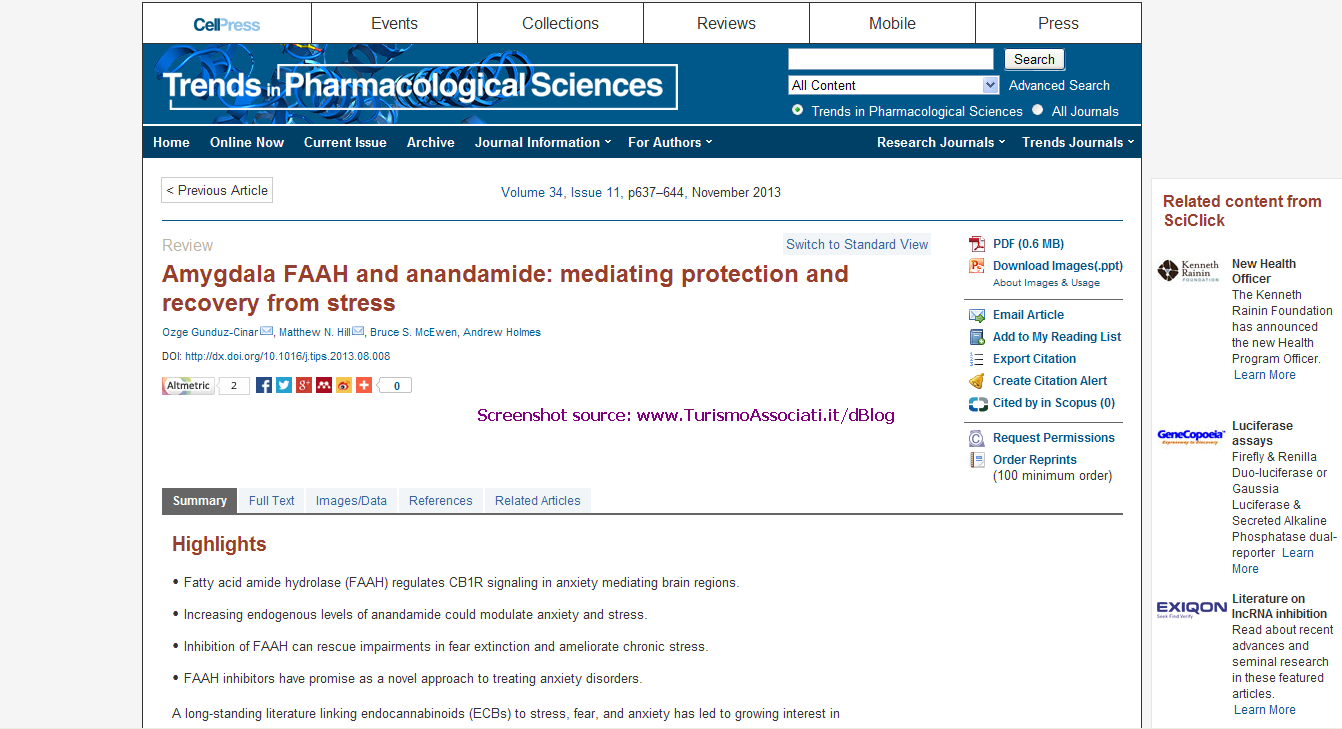|
Di seguito tutti gli interventi pubblicati sul sito, in ordine cronologico.
Published last month in the open-access journal PeerJ, investigators at the University of Reading say the findings strengthen support for chemicals in marijuana as seizure treatments.
"These results provide the first molecular confirmation of behaviourally observed effects of the non-psychoactive, anticonvulsant cannabinoid, CBDV, upon chemically (pentylenetetrazole)-induced seizures and serve to underscore its suitability for clinical development."
CBD (cannabidiol) and CBDV (cannabidivarin) have both shown anti-seizure potential in animal studies, but human trials have so far only involved CBD.

Using rat models, the researchers found that CBDV could suppress not only seizure activity, but the expression of specific epilepsy-related genes as well.
The team focused on a set of genes that are significantly increased in epilepsy and are thought to contribute to the disorder.
"Clear correlations between seizure severity and mRNA expression were observed for these genes in the majority of brain regions of CBDV + PTZ (pentylenetetrazole) treated animals and mRNA expression of these genes was suppressed in the majority of brain regions examined from the CBDV responder subgroup."
While the results can't confirm that gene suppression is directly responsible for CBDV's anti-seizure effect, the authors conclude that it provides "important acute biomarkers for additional investigation" of long-term treatment with CBDV.
The study was conducted as part of an ongoing epilepsy research project between GW Pharmaceuticals and Otsuka Pharmaceutical Co, Ltd.
Source: LeafScience
Researchers at Brigham and Women's Hospital and Harvard Medical School conducted a study comparing the psychoactive effects of Marinol (scientific name: dronabinol) – a THC pill used to treat nausea and weight loss in AIDS and cancer – with smoked marijuana.
Published in The Clinical Journal Of Pain, the team concluded that both forms of cannabis treatment have similar psychoactive effects.

"These findings imply that in our laboratory environment, dronabinol caused a 'high' similar to smoking marijuana when used for pain management."
Marinol was given to a group of 30 chronic pain patients who were also on opioid therapy. Their measurements were compared with 20 healthy subjects who received marijuana in joint form.
The study involved three separate laboratory visits, where participants were given the drugs and asked to complete a self-rated assessment commonly used to measure psychoactivity.
Although psychoactivity scores came back the same, the researchers did notice a difference in the time it took for effects to peak. The effects of marijuana peaked after 30 minutes, while Marinol's peak happened at around 2 hours.
The researchers suggest that a delayed peak may make Marinol less abuse-prone than smoked marijuana.
On the other hand, medical marijuana can be administered in edible form, which many say offers a similar delay. A recent study also suggests that patients who've tried different forms of marijuana prefer the whole plant over pharmaceutical preparations.
Nevertheless, the authors believe that increasing interest in cannabis-based medicine warrants further research on its abuse potential.
The study received funding from the National Institute on Drug Abuse (NIDA) and Solvay Pharmaceuticals, Inc.
Source: LeafScience
While many still debate the potential for marijuana to cause schizophrenia, researchers at Harvard Medical School say there has "yet to be conclusive evidence that cannabis use may cause psychosis."

Their latest study, published in the journal Schizophrenia Research, adds support to the role of genetic factors in schizophrenia, and that marijuana use alone does not increase the risk of developing the disorder.
"In summary, we conclude that cannabis does not cause psychosis by itself. In genetically vulnerable individuals, while cannabis may modify the illness onset, severity and outcome, there is no evidence from this study that it can cause the psychosis."

The team, led by Lynn DeLisi, MD, Professor of Psychiatry at Harvard Medical School, compared the family histories of 108 schizophrenia patients and 171 individuals without schizophrenia to determine whether cannabis use was a factor in developing the disorder.
They found that a family history of schizophrenia increased the risk of developing schizophrenia, regardless of whether or not an individual used cannabis.
The authors say further studies should investigate whether marijuana can interact with genetic factors to affect the age at which schizophrenia develops. However, the latest findings provide enough evidence for Dr. DeLisi and her team to conclude that cannabis "is unlikely to be the cause of illness."
Interestingly, the authors also point out that different types of marijuana may play a role in the outcome of schizophrenia.
"The amount of THC is particularly of concern, whereas CBD is the component that is thought to have medicinal value even in schizophrenia."
Indeed, although THC is known to have psychosis-like effects, there is growing evidence that CBD can counter the effects of THC, and may even be useful as a treatment for schizophrenia.
The study received funding from the National Institute on Drug Abuse (NIDA)
Source: LeafScience
One of the most common causes of erectile dysfunction is high cholesterol, which can clog blood vessels and weaken blood flow to the penis. Over time, it may also result in abnormal tissue build up, leading to permanent dysfunction.
But new findings published in the journal Clinical & Developmental Immunology explain how marijuana may help.

By targeting specific pathways related to marijuana, researchers from Switzerland were able to reduce erectile-related damage in mice with high cholesterol (hypercholesterolemia). These marijuana pathways, called CB2 receptors, are present in many parts of the body, including tissues of the penis.
"In summary, CB2 activation decreased histological features, which were associated with erectile dysfunction in hypercholesterolemic mice."
After three weeks of treatment, tissue samples taken from the mice showed lower levels of fibrosis (abnormal tissue build up) and other cholesterol-related injuries, compared to mice that were left untreated.
Though still in its early stages, the research is promising and helps shed light on the ongoing debate over marijuana and sexual function. Up till now, studies have mostly focused on marijuana's short-term effects, and have provided conflicting results.
The only research conducted in human subjects suggests that marijuana may have aphrodisiac-like effects. However, some pre-clinical evidence shows that another marijuana pathway, the CB1 receptor, may interfere with the ability to achieve an erection.
While the latest findings suggest that marijuana might offer long-term prevention against erectile dysfunction, the authors state that more research is needed to confirm the results.
The study received funding from the Brazilian Swiss Joint Research Program, the Swiss National Science Foundation, the Novartis Foundation and Conselho Nacional de Desenvolvimento Científico e Tecnológico (CNPQ)
Source: LeafScience
The work is being led by Dutch chemist and nanoparticle expert Willem Mulder, PhD, who has served as director of the Nanomedicine Laboratory at Mount Sinai since founding it in 2006.

Dr. Mulder and his team specialize in the use of nanoparticles in heart disease, and have recently taken an interest in the therapeutic potential of cannabinoids – a class of compounds found in marijuana.
Since 2005, pre-clinical evidence has shown that cannabinoids can slow the progression of atherosclerosis – a disease of the arteries that underlies various heart conditions – in mice.

Cannabinoids appear to be a promising treatment because of their anti-inflammatory properties. However, research in humans faces a number of barriers.
Dr. Mulder and his team believe that creating nano-drugs from cannabinoids may help to overcome one of the largest of these barriers: the 'high.'
Dr. Mulder has previously shown that nanoparticles, which are composed of an outer layer of fatty molecules, possess a natural attraction to the atherosclerotic plaque that accumulates on the inner walls of blood vessels.
By delivering cannabinoids via nanoparticles, Dr. Mulder says the drugs will never have to reach the brain, thereby avoiding any psychoactive effects.
Dr. Mulder told AD.nl in a recent interview that he hopes to start the first human trials sometime in the next 5 years. But in total, he says it could take 15 years for the therapy to reach the clinic.
Funding is another major obstacle of his research. In order to raise support for his work, Dr. Mulder has partnered with a team of Dutch filmmakers that are documenting his progress.
Led by Gert van Kempen, the High On Nano project will release a series of short films that will help bring the research to the public eye. They plan to raise €30,000 in order to begin production of the first episode by Spring 2014.
Source: AD.nl via LeafScience
GW Pharmaceuticals announced that it has been issued a Notice of Allowance from the U.S. Patent Office for a patent application involving the use of THC and CBD, the two main chemicals in marijuana, for treating gliomas.
Once a patent application is deemed a genuine invention, the Patent Office sends a Notice of Allowance that outlines the fees involved with final approval.

Specifically, the company provides this description of the patent:
"The subject patent specifically covers a method for treating glioma in a human using a combination of cannabidiol (CBD) and tetrahydrocannabinol (THC) wherein the cannabinoids are in a ratio of from 1:1 to 1:20 (THC:CBD) with the intent to reduce cell viability, inhibit cell growth or reduce tumor volume."
Filed in 2009, GW's patent application lists Otsuka Pharmaceutical as a collaborator and initially claimed the invention of the "use of a combination of cannabinoids in the manufacture of a medicament for use in the treatment of cancer."
However, it's likely that the application was revised since then to be more specific in its claims, including the ratio of THC to CBD used and the type of cancer treated.
Indeed, the use of cannabis and cannabis-derived chemicals to fight a wide range of cancers has long been suggested by pre-clinical research as well as anecdotal reports.
On the other hand, the first clinical trial to investigate these cancer treatments only began in november 2013, launched by GW Pharmaceuticals for their cannabis drug Sativex.
The trial investigates Sativex in combination with the standard chemotherapy drug temozolomide, and involves 20 patients with recurrent glioblastoma multiforme (GBM), an aggressive and rare form of brain cancer.
GW Pharmaceuticals also announced in November 2013 that it had begun human trials of a CBD-rich cannabis drug for the treatment of pediatric epilepsy.
Source: LeafScience
Published in the December 2013 issue of Epilepsy & Behavior, the survey compiled responses from 18 parents who had turned to CBD (cannabidiol)-rich cannabis extract to treat their child's severe epilepsy.
Of those surveyed, 83% indicated a reduction in their child's seizure frequency. Parents reported little to no side-effects of cannabis treatment, and, in some cases, a reduction in seizure frequency of up to 80%.

Thirteen of the children suffered from Dravet syndrome, four had Doose syndrome, one had Lennox-Gastaut syndrome and one had idiopathic epilepsy.
The study was led by postdoctoral fellow Catherine Jacobson, PhD, who believes in spite of the study's obvious weaknesses, that the results still support CBD-rich cannabis as an effective epilepsy medicine.
"Even given the caveats of the study, which are big, I believe that CBD will work for some children that are currently still seizing despite their trials of available anti-seizure drugs."
Dr. Jacobson says she was inspired to conduct the study by her own search for a treatment that could help her epileptic son. After hearing that some parents were having success using CBD-rich cannabis, she reviewed the literature and found research dating back to the 1970s that supported the anecdotes.
And while medical marijuana is legal in her home state of California, Dr. Jacobson believes that more research needs to be done in order for CBD to be widely accepted and available.
"Now the work begins, though, to find out which types of epilepsy it's going to help, how CBD interacts with other anti-seizure drugs, and what really are the side-effects?"
CBD remains strictly prohibited as a Schedule I drug, making it difficult for parents in many states to access the treatment. However, significant progress has been made in the past year towards achieving federal recognition of CBD as a medicine.
In fact, Dr. Jacobson is now part of a team at University of California, San Francisco (UCSF) that is leading clinical investigations on a high-grade CBD extract developed by GW Pharmaceuticals.
Just last month, the company announced that it had received FDA approval to begin experimental treatments with the new drug, Epidiolex, in epileptic children.
Research is being led by Roberta Cilio, MD, PhD at UCSF and Orrin Devinsky, MD at the NYU School of Medicine, and initial results are expected.
Source: LeafScience
Di Salvatore Santoru

Peter Brabeck Letmathe è l'attuale amministratore delegato della Nestlè, la più grande corporation nel settore dell'alimentazione .
In un'intervista del 2005 apparsa sul documentario " We Feed the World ", affermò praticamente che quello all'acqua non si poteva considerare un diritto per gli esseri umani, dichiarando che l'acqua non è altro che un prodotto commerciale, e per questo è lecito che venga privatizzata e quindi detenuta in poche mani .
Le sue testuali parole sono :
" La questione su cui riflettere è bisogna o no privatizzare l'acqua ? Si scontrano due punti di vista, su ciò, il primo che definirei estremo è rappresentato dalle ONG per le quali l'accesso all'acqua dovrebbe essere nazionalizzato, in altre parole tutti gli esseri umani devono avere accesso all'acqua.
Questa è una soluzione estrema, e l'altro che dice che l'acqua è un prodotto alimentare e come tutti i prodotti alimentari ha un valore di mercato " .
Continua Letmathe : " è preferibile, secondo me dare sempre un valore a un prodotto cosicchè tutti noi siamo coscienti che tale prodotto ha un valore e che si possano attuare delle misure adeguate " .
Come riporta la sua pagina di Wikipedia, Letmathe è anche membro del consiglio di amministrazione della compagnia petrolifera ExxonMobil, di proprietà dei Rockefeller, una delle più potenti famiglie di banchieri e industriali internazionali .
Interessante è sentire il famoso discorso all'ONU di David Rockefeller, in cui il famigerato banchiere e petroliere afferma che essendoci sempre meno risorse da sfruttare, praticamente bisogna dimezzare la popolazione .
Letmathe è anche membro del consiglio di amministrazione di Credit Suisse e dell' Oreal, una delle più grandi multinazionali specializzate in cosmetici e altri prodotti di bellezza .
L'industriale è anche membro del consiglio di fondazione del " World Economic Forum " e membro della European Round Table of Industrialists, una lobby fondata nel 1983 che riunisce i più grandi manager delle multinazionali con sede in Europa e che ha una forte influenza sulle decisioni economiche prese dall'UE .
Ha anche partecipato alle riunioni del Bilderberg, il meeting che riunisce le più potenti personalità dell'alta finanza,della grande industria e della politica, e il cui obiettivo è la costruzione di un'unico governo mondiale guidato dai potentati finanziari e industriali .
Inoltre,come rivelato dall'agenzia di news " Bloomberg ", ultimamente la Nestlè ha anche lavorato con i Rothschild per studiare la vendita di asset in Sud America .
Letmathe ha fatto capire a che cosa sta lavorando l'elitè mondiale : un mondo basato sulla mercificazione totale dell'essere umano e di ciò che lo circonda, schiavo della dittatura del denaro e del potere di pochi oligarchi che per mezzo di esso esercitano il loro immenso potere sul resto dell'umanità .
Fonte: http://informazioneconsapevole.blogspot.it/2014/05/per-la-nestle-gli-esseri-umani-non.html
Here we count down, in no particular order, a few (of the many) reasons why this year was memorable for cannabis research.

1. FDA approves first clinical trials of marijuana for paediatric epilepsy
Evidence that marijuana can help in a wide range of epileptic conditions dates back to the 70s. But it wasn’t till this year that research progressed to the stage of FDA-approved clinical trials.
Likely due, at least in part, to growing interest from the media and awareness among parents with epileptic children, a company called GW Pharmaceuticals this year became the first ever to initiate clinical trials of a cannabis-based epilepsy treatment. The drug is called Epidiolex and is a liquid extract high in the non-psychoactive marijuana chemical called cannabidiol (CBD).
Initial results are expected early 2014 and, if successful, may not just bring relief to thousands of children across the U.S for whom traditional medicines don’t work. In fact, clinical evidence that cannabis extract helps in paedetric epilepsy could very well lead to the rescheduling of cannabis under U.S. federal law.
Read more: New Cannabis Drug Approved For Trials In Children With Epilepsy
2. Scientists show that various chemicals in marijuana can kill leukemia cells
Evidence that marijuana can kill cancer cells has also existed for decades. But this year, research from the University of London revealed something very interesting.
Using leukemia cell lines, the study identified the cancer-fighting potential of a number of lesser known, non-psychoactive chemicals in marijuana.
Unlike THC, the compounds that were used in the study – cannabidiol (CBD), cannabigerol (CBG) and cannabigevarin (CBGV) – can’t get patients high. Significant media attention was paid to this point. On the other hand, it’s doubtful that getting high is a major concern of anyone battling cancer.
Read more: Cannabinoids Destroy Leukemia Cells, New Study Finds

3. First clinical trials of marijuana for brain cancer begin in the UK
On top of breakthroughs in non-psychoactive cannabis treatments, 2013 also marked the launch of the first ever human trials of cannabis-based cancer medicine.
In November, GW Pharmaceuticals announced the start of Phase 1b/2a clinical trials of their pharmaceutical cannabis spray, Sativex, as an add-on treatment for aggressive brain cancer. The two-part trial involves giving Sativex to 20 patients with recurrent gliobastoma multiforme, in addition to the standard chemotherapy drug temozolomide.
While THC and CBD have both been shown to kill cancer cells on their own, some research suggests that combining marijuana compounds with traditional chemotherapy drugs can have even greater anti-cancer effects.
Read more: Cannabis Treatment For Brain Cancer Begins First Human Trials
4. Researchers show that marijuana can help cigarette smokers quit
Marijuana may not just be a safer recreational drug than cigarettes, but apparently it can also help cigarette smokers quit. The first human study to investigate this was conducted at the University College London, with the results published September this year.
The small, placebo-controlled trial involved the non-psychoactive marijuana compound CBD administered via vaporizer, which subjects were instructed to use whenever they felt the urge to smoke.
After one week of treatment, those who received actual CBD showed a 40% reduction in the number of cigarettes smoked, compared to the placebo group. The researchers concluded that the results were promising, but since the study only involved 24 subjects, larger studies are still needed.
Read more: Can Marijuana Help You Quit Cigarettes? Study Says Yes
5. Scientists provide first clinical evidence that marijuana helps in Crohn’s disease
In May, researchers out of Israel published results from the first human study investigating smoked medical marijuana as a treatment for Crohn’s disease. While the study was rather small, only 11 patients were involved, daily doses of medical marijuana led to complete remission in 5 of the patients.
Medical marijuana also helped patients wean themselves from dependency on steroid-based medications and improved their appetite and sleep, with “no significant side effects.”
While the study focused mostly on symptom measurements, the results may also support earlier findings from animal studies showing that compounds in marijuana can actually treat the underlying cause of Crohn’s and other inflammatory bowel diseases.
Read more: Cannabis induces a clinical response in patients with Crohn’s disease: a prospective placebo-controlled study.
6. Scientists provide first clinical evidence that marijuana helps in Parkinson’s disease
With animal and cell culture studies suggesting that marijuana may slow the progression of Parkinson’s, it was only a matter of time until human research was conducted.
Thankfully, Israeli researchers also published the first ever human study of medical marijuana for Parkinson’s this year. Although only 20 patients were involved, the results showed clear improvements in symptoms of tremor, rigidity and bradykinesia.
Patients also reported a dramatic reduction in pain associated with their disease, which led to improvements in sleep. Overall, measurements of disease severity taken after patients smoked medical marijuana showed a significant decline that lasted for around 2 to 3 hours.
Read more: Smoking Pot Eases Tremors in Parkinson’s
7. Harvard study shows smoking marijuana may make you skinnier and reduce the risk of diabetes
This year, an observational study involving over 4,600 adults, conducted at Harvard University, revealed a rather surprising link between marijuana use and slimmer waist lines.
Although suggested before, the link still seems counter-intuitive, since marijuana isn’t known for reducing food intake, but rather the opposite. Indeed, other studies suggest that marijuana users have a significantly higher calorie intake than non-users.
However, the Harvard study also found lower levels of insulin blood levels and insulin resistance among marijuana users, as well as higher levels of the ‘good’ type of cholesterol (HDL), all of which are believed to lower the risk of diabetes.
Considering the newest data, the researchers concluded that while marijuana is well known for stimulating a desire for unhealthy foods, it may have some less obvious metabolic effects that could be healthy in the long run.
Read more: Marijuana: The Next Diabetes Drug?
Source: LeafScience
Published in Trends in Pharmacological Sciences, a team of experts from the National Institutes of Health (NIH), University of Calgary and The Rockefeller University summarized the current body of research on cannabis and anxiety.
As it turns out, despite marijuana's wide range of effects, relief from anxiety and stress happens to be the most commonly reported reason for using marijuana.
"Cannabis and its derivatives have profound effects on a wide variety of behavioral and neural functions, ranging from feeding and metabolism to pain and cognition. However, epidemiological studies have indicated that the most common self-reported reason for using cannabis is rooted in its ability to reduce feelings of stress, tension, and anxiety."

Studies involving THC also show that it "can reduce anxiety in patients with anxiety disorders," continue the authors. On the other hand, too high of a dose can have the opposite effect in certain people.
But while marijuana has long been regarded as an effective stress reliever, recent research has focused on the neurological activity responsible for this effect. What scientists now know is that marijuana acts on a system in the brain called the endocannabinoid system.
Interestingly, the authors also note evidence that suggests anxiety disorders could be caused by abnormalities of this biological system.
"The discovery of the ECB (endocannabinoid) system raised the possibility that ECBs (endocannabinoids) could be important modulators of anxiety, and might contribute to individual differences in anxious temperament and risk for anxiety disorders."
Among its various functions, the endocannabinoid system is believed to naturally regulate anxiety and stress levels. It does this through the release of chemicals that belong to the same class of chemicals found in marijuana: (endo)cannabinoids.
Though scientists have identified over 60 different cannabinoids in the cannabis plant, its main psychoactive ingredient, THC, is strikingly similar to one of the first endocannabinoids discovered in humans, anandamide.
By acting on the same pathways of the brain, both seem to hold promise as a treatment for stress and anxiety. So it's no surprise that people who suffer from excessive stress are finding relief in marijuana, a phenomenon that scientists call "self-medicating."
"Significant numbers of people may be self-medicating with cannabis in an attempt to reduce excessive anxiety."
But whether cannabis is the best way of targeting the endocannabinoid system is still up for debate.
In fact, the authors of the latest report argue that raising the brain's anandamide levels – by preventing its breakdown – may be a better therapeutic alternative, due to the "unwanted effects of cannabis (e.g. cognitive impairment, abuse liability)."
However, with no clinical trials of a drug that can do this, it may be a while until such an alternative is available.
Source: LeafScience
|